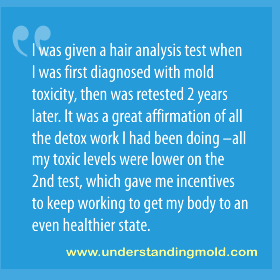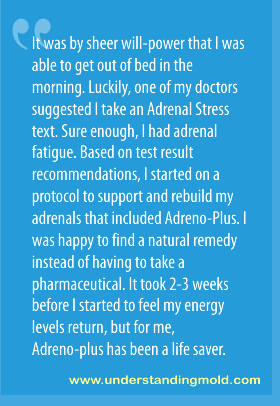The right doctor will know how to fully diagnose and treat you. Aside from the general battery of blood tests to determine your general state of health, here are some tests that your doctor might use or that you might consider asking for:
1) Mold Allergen-specific IgG Antibody Tests
LabCorp has the following quantitative allergen-specific IgG antibody blood tests for molds. These IgG antibody tests can be used to show exposure to specific molds and mycotoxins.
| Algae 612598 Alternaria tenuis 069252 Aspergillus amstelodam 612184 Aspergillus fumigatus 069260 Aspergillus nidulans 611822 Aspergillus niger 060715 Aspergillus terreus 612069 Aspergillus versicolor 612077 Aureobasidium pullulans 067330 Bipolaris spicifera 612580 Botrytis cinerea 066506 Candida albicans 069278 Cephalosporium acremonium 069492 Chaetomium globosum 060954 Cladosporium cladosporidies 612226 Cladosporium herbarum 069286 Curvularia lunata 060723 Epicoccum purpurascens 069948 Epidermophyton floccosum 060006 Fusarium culmorum 612135 Fusarium moniliforme 612218 Fusarium oxysporum 612424 Helminthosporium halodes 612234 |
Helminthosporium interseminatum 612499 Hormodendrum hordei 067660 Mucor plumbeus 612523 Mucor racemosus 069294 Mycogone 612531 Neurospora sitophila 612192 Nigrospora oryzae 612440 Paecilomyces spp 612200 Penicillium brevicomo 612028 Penicillium notatum 069302 Phoma betae 067447 Pityrosporum orbiculare 060276 Rhizopus nigricans 067645 Rhodotorula 612549 Serpula lacrymans 060089 Spondylocladium 066662 Sporobolomyces roseus 611996 Stachybotrys chartarum 060017 Stemphylium botryosum 650309 Trichoderma viride 610204 Trichophyton mentagrophyt 069534 Trichophyton rubrum 060008 |
“An immunoglobulin test measures the level of certain immunoglobulins, or antibodies, in the blood. Antibodies are proteins made by the immune system to fight antigens, such as bacteria, viruses, and toxins. The body makes different immunoglobulins to combat different antigens. Once an antibody is produced against a specific antigen, the next time that antigen enters the body, the immune system “remembers” its response and produces more of the same antibodies. In that way, checking for the presence of specific immunoglobulins in the blood can be helpful in diagnosing or ruling out infections or certain other illnesses.” — KidsHealth.org
2) Hair Analysis for Toxic and Essential Elements
 The Doctor’s Data Toxic & Essential Elements Hair Analysis tests your hair sample to see what toxic metals you have in your system and how much. Also tests for essential elements and minerals that your body needs to function…to see if they are within range or too high/low.
The Doctor’s Data Toxic & Essential Elements Hair Analysis tests your hair sample to see what toxic metals you have in your system and how much. Also tests for essential elements and minerals that your body needs to function…to see if they are within range or too high/low.
Extensive research established that scalp hair element levels are related to human systemic levels. The strength of this relationship varies for specific elements, and many researchers consider hair as the tissue of choice for toxic and several nutrient elements. Unlike blood, hair element levels are not regulated by homeostatic mechanisms. Thus, deviations in hair element levels often appear prior to overt symptoms and can thereby be a valuable preliminary tool for predicting the development of physiological abnormalities.
This test is inexpensive (about $100) and is noninvasive. A good stylist can take hair from the back of your head in a way that no one will notice.
> Learn more about Doctor’s Data Toxic & Essential Elements Hair Analysis
> See Sample Test Results
3) Adrenal Stress Test
 If you are suffering from chronic tiredness, it is possible that you might have adrenal fatigue. Many times, when you present to the doctor with fatigue, hair loss, and other symptoms; the doctors will test your thyroid but do not think to actually test your adrenals. Healthy adrenal glands are important for energy, muscle and joints, bone health, immune system, quality of sleep, skin regeneration, and thyroid function.
If you are suffering from chronic tiredness, it is possible that you might have adrenal fatigue. Many times, when you present to the doctor with fatigue, hair loss, and other symptoms; the doctors will test your thyroid but do not think to actually test your adrenals. Healthy adrenal glands are important for energy, muscle and joints, bone health, immune system, quality of sleep, skin regeneration, and thyroid function.
James Wilson, PhD, the author of Adrenal Fatigue, writes that symptoms include:
- Trouble getting out of bed
- Chronic tiredness, even after you wake up in the morning
- Trouble thinking clearly or finishing your tasks
If you are suffering from mold illness or toxicity, your body and immune system are dealing with extreme stress from your environment. On top of that, if you are dealing with other life stresses, it makes sense that your adrenals may be struggling to catch up. If you can barely get out of bed in the morning and/or are losing your hair; consider having an adrenal stress test done. If you test for adrenal fatigue, you can support your adrenals while you heal your body and get your environment healthier. I took Adreno-Plus to rebuild my adrenals and support them while recovering from mold toxicity.
DiagnosTechs has an Adrenal Stress Index Panel that costs about $220. They also have an online evaluation form that scores on the spot to tell you if taking an Adrenal Stress Index Panel is warranted.
> Information about the Adrenal Stress Index Panel
> Take the Stress Test Evaluation for the Adrenal Stress Index
4) Gluten Intolerance & Other Sensitivities

This is THE book that caused a HUGE light bulb go on for me about this issue. It has a great section that talks about medical studies looking at the overlap of gluten sensitivity with patients with other illnesses including skin disorders, neurological diseases, other autoimmune disorders, digestive disorders, and undiagnosed disorders and conditions.
>The Gluten Connection: How Gluten Sensitivity May Be Sabotaging Your Health – And What You Can Do to Take Control Now
Okay, I know that testing for Gluten Intolerance may seem like a strange thing to list here, but hear me out. If toxins in your environment are attacking your body, your body and immune system is already in major distress. There are already probably some levels of inflammation going on in your body even if you don’t recognize them. If you have even an intolerance to Gluten, and I’m not even talking Celiacs at this point, then every time you have even a little bit of gluten, an auto-immune reaction occurs in the body. So, one more layer of distress and immune system reaction is the last thing that you need.
Gluten is a protein contained in the grains wheat, barley, rye, and oats. It is a unique protein based on its structure that lends a doughy/elastic consistency to flours derived from these grains. This is why over the centuries, gluten-containing grains have come to be used so extensively in breads and other baked goods. These gluten-containing grains we eat today are actually domesticated and now genetically hybridized versions of what originally were wild grasses endemic to the Tigris-Euphrates river basin. The nature of the toxicity, although to some extent stems directly from the chemical nature of gluten, is mostly due to a reaction that occurs by the immune system of individuals in possession of certain genes that recognize gluten for the foreign protein that it is and hence toxic. The immune system genes in control of this reaction are actually not rare, and may be present in up to 60% of Americans.
It took me a long time to figure out what the gluten connection is so important. This isn’t just an allergy folks, it causes an auto-immune reaction and that is serious stuff.
> EnteroLab has a Gluten Sensitivity Stool Panel that is way more reliable than the blood test your doctor will probably want to give you. They can also test for food sensitivities if you are interested. Minimizing exposure to antigenic foods is an important component of an anti-inflammatory lifestyle to optimize immune system health.
> Enterolab’s Frequently Asked Questions


